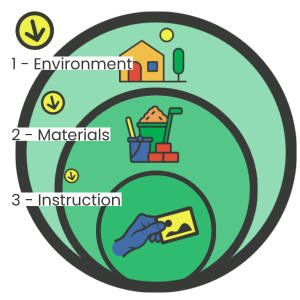Publication Date:
revised 9/29/2023
 The inclusion framework is informed by evidence-based inclusive practices (e.g., Campbell & Milbourne, 2007; DEC, 2014) and focuses on the supports adults can implement to facilitate STEM learning for children with disabilities.
The inclusion framework is informed by evidence-based inclusive practices (e.g., Campbell & Milbourne, 2007; DEC, 2014) and focuses on the supports adults can implement to facilitate STEM learning for children with disabilities.
Within the hierarchy, adaptations to the environment and materials are aligned to the Division for Early Childhood (DEC) Recommended Practices on environment while instructional adaptations are aligned to the Recommended Practices on instruction. .
1. Environment (e.g., room set-up, equipment, how an activity is done, length of time)
2. Materials (e.g., adaptations to toys, materials, assistive technology devices)
3. Instruction (e.g., add information, reduce steps)
Audience:
- Faculty & PD providers
- Families
- Practitioners
Developmental stage:
- Birth-5
Setting:
- Center/Preschool
- Home
Resource Type:
- Guides
Topic:
- Accommodations (adaptations, supports)
Level of Intended Impact:
- Knowledge acquisition
- Knowledge application
Language:
- English
- Spanish
Routines and Everyday Activities:
- Bedtime & Nap
- Group activities (circle time, tabletop activity)
- Mealtime
- Personal care (diapering/toileting, toothbrushing, bathing)
- Playtime (indoors & outdoors)
- Storytime
- Transitions
